Helping Where Governments Fail
The increasing importance of social entrepreneurship in overcoming social problems and structural barriers
The language of traditional business usually evolved around financial terms with the ultimate goal of any economic activity having been the maximisation of financial return on investment. However, in the last years there has been a noticeable shift away from financial to social return and the value creation for the many rather than a few. This transformation is greatly reflected in the uprise of social entrepreneurship around the world.
Even though social entrepreneurship is not a new concept, it gained increasing importance during the last decade. At this point, many ideas of early social entrepreneurship pioneers have evolved to commercialised and mainstreamed versions of the initial models e.g. car sharing or micro-finance. Distinct from conventional entrepreneurship, social entrepreneurship functions as a societal change agent.
As non-profit Ashoka puts it:
“Rather than leaving societal needs to the government or business sectors, social entrepreneurs find what is not working and solve the problem by changing the system […].” 1
This description emphasises perfectly the relevance of social entrepreneurs in overcoming social structural barriers in areas where governments cannot act sufficiently or flexibly enough or in some cases even cause the problem. Trying to tackle the most pressing social problems, it is little wonder that many initiatives of social entrepreneurship have emerged in the field of migration.
Coming from Berlin, a city whose face has changed drastically over the last two years due to the influx of refugees, I can observe first-hand the crucial role that social entrepreneurs play in alleviating the harsh realities of asylum seekers in Europe. There are many challenges, which need to be named when it comes to migration, that are evolving and changing constantly in the dynamics of global politics and societal movements. In order not to repeat its mistakes with guest workers in the 1960s, Germany now has to successfully manage a process of social integration spanning the facets of economic opportunities, personal fulfilment, recognition as well as individual identity. Societal incoherence, missing political actions and legal restrictions, however, pose barriers to this process, which often are best tackled in grassroots social entrepreneurship projects.
A great example of a company overcoming structural barriers is CUCULA, “The Refugees Company for Crafts and Design”. CUCULA describes itself as “an association, a workshop and an educational program all in one.” 2 Trying to find a pragmatic solution to counteract the state of helplessness of refugees upon arrival in Berlin, CUCULA is training refugees in the manufacture of premium design furniture. As income generation is illegal in situations in which asylum is not granted yet or a work permit is not issued, CUCULA invests the revenues from selling the furniture into educational measures including German language classes or legal advice in order for the refugees “to build their own professional future”. The clever concept of CUCULA opens new opportunities for refugees to make us of their abilities, receive compensation and acquire new skills without falling under the legal definition of paid labor.
As mentioned before, personal fulfilment, recognition and economic opportunities are essential factors for social integration. Nevertheless, creating situations of cultural encounters promoting direct social exchange and relationships with the local community is the fundamental base for integration. The social business “Über den Tellerrand kochen” uses cooking as the most accepted medium for cultural exchange and tries to introduce concrete individuals hidden behind the ambiguous topics of flight and asylum via recipe books and cooking classes 3. The business’ name is a pun playing with the German expression for “seeing beyond the end of your nose” but changing it to “cooking beyond the end of your nose”. In a fresh and uncomplicated manner they are creating a place of contact and a common future for locals and refugees and by doing so help to reduce stereotypes and fears.
With the proceeds from the cooking classes and the recipe books, the company is financially supporting the “Über den Tellerrand Community”. The open community of locals and refugees promotes different activities for cultural exchange such as sport events, creative workshops, barbecues etc. with great flexibility being left to the members of the community in creating ideas according to their interests and needs. In order to scale the project, the founders created a handbook on all steps necessary for implementing the project in other places and the project has seen great success being put into place in other German cities. The movement has even led to activities in different European countries such as Italy and the Netherlands. This collaborative and self-feeding evolutional process is one of the success factors of social entrepreneurship giving it advantage over traditional competition oriented business strategies and the rigidness of governmental intervention and solutions.
1 https://www.ashoka.org/social_entrepreneur
2 http://www.cucula.org/en/concept/
3 https://ueberdentellerrandkochen.de
ONE: number of people needed to change the world
Coming to class by Metro, I was surprised by an advertisement from an NGO that states exactly what I chose to be the title of this post. And it is because I actually believe that only one person is needed to bring change and improve the world we live in. Maybe I can be criticised for this naïve philosophy of life, but I do not think I am the only one who believes in this stament. It was not a coincidence the fact that this advertisement also reminded me one phrase from our Social Entrepreneurship lectures at EOI that really inspired me:
“Forget how things are;
Think how things should be”
After seven years I left High School, I still remember one of my economy lectures. The teacher explained us different definitions and figures but I kept the figure of Schumpeter and his theory regarding the importance of innovation and entrepreneurship for economic development. Even though he explained these (apparently new) concepts and economic theories at the beginning of the twenty first century, nowadays, innovation and entrepreneurship are also at the stake for growth. They are at the stake of bringing change to our societies.
What do I mean by bringing change? What does change mean? Its polysemy made me choose one Oxford definition that states change as “an act or process through which something becomes different”. It is clear to associate entrepreneurship and innovation to a process through which something becomes different, something which improves regarding an identified problem or challenge. Behind the words entrepreneurship and innovation there are people. People with passion and willing to contribute their bit to make things happen. These people can be individuals, citizens or can be organized in companies, NGOs and other kind of institutions, such as the Public Sector. These groups form heterogeneous societies and systems which we are part of.
Once we arrive at this point, it is key to distinguish between two ways of building a meaningful and impactful career: social entrepreneurship and social intrapreneurship. To make the story short: while the first term is related to create your own social business the second concept is about working as an entrepreneur in an already alive corporation. How?
First thing to make clear is that the figure of a social entrepreneur differs from the traditional entrepreneur and also from an entrepreneur that opens a “green business”. According to Ashoka, the largest network of social entrepreneurs worldwide, social entrepreneurs are individuals with innovative solutions to society’s most pressing social problems. They are ambitious and persistent, tackling major social issues and offering new ideas for wide-scale change. In other words, they are change makers.
For the second term, in 2014, also Ashoka made a contribution in Forbes magazine. The article was titled “The most valuable employee: the social intrapreneur” and states the following definition:
“Social intrapreneurs are right now sitting within existing organizations at the intersection of innovation, social good, and entrepreneurship. They can be found at all levels of the organization and from any generation, working under the radar and struggling against bureaucracy to launch new programs, products, and initiatives that leverage the changemaking ability of established institutions. By acknowledging the value of social intrapreneurs, large companies create narratives on how their employees are making a difference in the world. For the social entrepreneurs struggling to scale their impact and lacking the resources and network for high level impact, finding or becoming the intrapreneur can change everything”
Reading the two definitions it is clear to see that the aim is the same, what is different are the means and the framework. But what do these terms mean in terms of driving change?
Coming back to Schumpeter, his traditional view can be complemented with the fact that there are more inputs needed to be a sustainable business beyond the money. The traditional decision making processes based on financial information is falling behind, and sometimes profit is not an end but a mean to be sustainable. Therefore from my point of view this new approach far from the Business as Usual scenario, is what can make the difference in a global and interconnected world. No matter where you are: if it is Madrid, a coastal village in the north of Spain, an isolated region in Africa or an island in the Pacific… The world is full of challenges to be addressed, but also people willing to make our Earth a better place to live in.
Though, the systems are made by people, they are the product of a process and also the corporations are made in this way. The fact that something is established does not mean that it cannot be done better, and this is where you can find the spot for change. Somewhere in a big corporation, somewhere in a small one, or even in the form of mere ideas at a very early stage of curiosity in someone’s brain.
¿TE QUEJAS O EMPRENDES?
“I cannot. It’s impossible. No one can do that. This situation is horrible. We cannot change that. It is too difficult. It is not my fault. I do not have enough time. I don’t want. Things are like this and that’s all. Some people are in a worse situation. You have to deal with that.”
Which of those sentences is your favourite one? Or which one of them are you usually take as your excuse?
We love to look for excuses in order to avoid doing difficult challenges, and even more we love to complain about our current situation and status quo. That’s why we do not even try to look for solutions; but we eager to look for people who are willing to listen to our problems and complaints. However, time passes by and our problems remain. This is why we need to change our mind-set and put an effort to finally tackle the issues that are bothering us.
With this urge and desire of tackling and solving particular social problems the term social entrepreneurship was born. How cool is making business by tackling a social issue? The term refers to the practice of combining innovation, resourcefulness and opportunity to address critical social and environmental challenges. As you know, entrepreneurship means starting, exploring and taking risks, but all of it in a context of freedom, where we can use our creativity and take advantage of the opportunities that are around us.
There are not that many barriers that are actually stop us to start a new project or to develop an idea. The main obstacle that usually comes to our minds is the financial one. However, talking about social entrepreneurship, this must be the last thing that worries us.
So, if there are way more advantages than barriers why the term of social entrepreneurship is not very popular in Spain?
From my point of view it is a matter of education. And with education I’m not only talking about the School and the University. The environment and the context where you grow are also crucial. In Spain, we are so used to not leave our comfort zone. Why should we take risks if there is the possibility to fail? If something is bothering you, stop complaining, stand up and look for a solution. Look for like-minded people who share your worries and try to create a game-changing idea out of these concerns! In my hometown, Madrid, you can find wonderful co-working spaces, such us the Impact Hub, where you can share ideas and develop them. The idea of working alone, from my personal experience is not useful anymore. The perfect idea is always coming by sharing knowledge and perspectives. And that this not only my opinion you can see with the more than 200 co-working spaces around Madrid.
But, coming back to the Education aspect. The traditional education system is based just in the transmission of information, in a theoretical perspective, and in the changing world where we live this is not longer sustainable. The entrepreneurship education is related to high levels of education, to the last steps before accessing the businesses world. Something that is completely wrong. It is necessary to change the education system and adapt it to the reality, implementing creativity and innovation in the day to day of children. The education must be visual and more practical in order to let the children think by themselves since they are young.
Innovation and the Access Economy
The rapid and disruptive ascent of the sharing economy has fundamentally changed the competitive landscape. Not only has it resulted in approximately 17 companies valued at $1 billion but reflects a deep seated shift in how products are consumed, services delivered and business conducted.
Companies like Uber, Airbnb, Alibaba and Facebook are the largest providers of transportation, accommodation, retail and media content, yet they own no cars, no real estate, no inventory and produce no content.
In many ways, this reflects a more poignant change in how we access things. While the expansion of access is the interesting story, if is often last amongst efforts to reconcile the many characterizations of the sharing economy (e.g., is it really sharing?). To be fair, there are many reasonable critiques of the sharing of the economy (see Schor, 2014; Ekhardt and Bardhi, 2015; Kesher, 2015; Hill, 2016; Slee, 2016).
The purpose of this post is not to examine such critiques or debate what constitutes the sharing economy. Rather, it is more interesting to explore how web-based platforms have transformed market dynamics premised on access and the corresponding term of the ‘access economy’. The access economy assumes consumers place grater importance on lower costs and convenience than fostering social relationships with a company or other consumers. In this respect, the research of Ekhardt and Bardhi (2015) observed that many consumers prefer the advantages of renting because it allows “convenient and cost-effective access to valued resources, flexibility, and freedom from the financial, social, and emotional obligations embedded in ownership and sharing.”
This is an important insight not only in terms of companies pivoting from business models premised on ownership to renting but also understanding how firms can change how they access the resources that drive innovation. In doing so, it is important to briefly consider two secular trends in the global economy observed by Lakhani et al., (2013):
- ‘Digitization’ – the transformation of material objects and their increasing ‘information shadow’ and now their representation as digital goods. Consequently, “material and physical objects can now be created, represented, modified and transformed with the same relative ease as software goods.” This allows for task decomposition in many parts of the economy.
- The increasing number of actors who can participate in knowledge production at very low costs. Advancements in internet and related technologies have democratized the tools of knowledge creation, significantly reducing the costs of knowledge dissemination, communication and coordination. As a result, this has made it easier to find and access distributed knowledge (regardless of geographic location).
More and more physical products have digital dimensions with aspects that can be broken down. Combined this with greater numbers of people with knowledge and skills that can be accessed from anywhere, and it creates new opportunities for companies to find and tap into creativity and innovation outside of their organizational boundaries.
In recent decades, firms have increasing seen the value of moving from a closed innovation model (i.e. the old school R&D department) to more open and fluid arrangements with external networks and communities, whose knowledge and capacity can be leveraged to co-create and innovate. Consequently, this led to what Henry Chesbrough coined ‘open innovation’. Open innovation refers to “the use of purposive inflows and outflows of knowledge to accelerate internal innovation and expand the markets for external use of innovation.” In other words, companies should use processes that use and integrate ideas both external and internal into their platforms, architectures, and systems to advance innovation.
Open innovation elevates the role of collaboration in marking it essential to a firm’s competitive advantage. For organizations utilizing open innovation strategies (e.g., LEGO, Apple, Toyota and even NASA) is about being able to access technology, human resources, etc. through both conventional partnerships and dispersed networks like on-line communities.
In this respect, not only are we seeing changes in business models reflecting the emphasis on access (i.e. renting vs. owning) but the need for new organizational designs to accommodate even reconcile the logistics of open innovation vs. closed. This highlights the need for ambidexterity in organizational design because it is increasingly difficult to innovate in closed model alone.
The present age is connected by increasing array of digital networks that are increasing the speed of exchange, range of knowledge dissemination and opportunity for collaboration. Accessing the power of the crowd is a path to innovation. It offers companies cost-effective access to valued resources and financial flexibility. Companies can have access, if they are open to it.
Social Innovation – Innovation for Everyone
According to Wikipedia Innovation is defined simple as a “new idea, device, or method”. According to most of the people innovation is rather some technology-related thing, such as electronic devices or any new mobile app, than an idea or method. However, technological innovative products are usually available for just a small number of the world’s citizens and does not reach the people who really would need improvement and progress. Those people need meaningful innovation addressed to their problems and needs. In other words they need social innovation. Social innovation is an inter-sectoral approach with new strategies and concepts addressed to social needs and issues with the goal to create an added value within the whole society. On the basis of two examples I will illustrate how a little change of our perspectives or new business approaches can lead to social innovation and thus changes the lives of millions of people.
The first good example is microcredit. A concept where small loans are given out to impoverished people who usually never had access to any kind of financial credit. This inclusive approach which is addressed to the poor people at the bottom of the pyramid was a revolutionary change with many advantages and benefits across different communities worldwide. The facilitation of paperwork and especially the empowerment of woman and the introduction to financial services has improved and stabilized many families in poor communities around the globe. Last but not least it incentivised entrepreneurship in poor communities and enabled hundred thousand of people to start their own small business and consequently manage their daily challenges more independently. The elimination of this financial barrier for poor people by introducing the concept of microcredit was certainly one of the most game-changing social innovations in recent times.
Aside from this inclusive and “bottom of the pyramid” approach another way to tackle social issues is to put terms such as collaboration (instead of competition) or sharing (instead of owning) in the centre of business strategies. There are already several big companies which have noticed that doing business and creating an added value for the society can be very profitable. One of these businesses is the car sharing concept Car2go by Daimler. Daimler has realized that for people cars are not the same status symbols anymore as in the past but that the need for cars is still high and even increasing. Furthermore, cars are often too expensive and too inconvenient in big cities regarding parking and space. Hence, Daimlers came up with the great idea of providing cars for cities and let the people use and share them. According to the size of the city a certain amount of cars are provided and distributed, ready to use for all registered members to comparatively low costs. Thank to this revolutionary business model financially weaker people get access to better mobility opportunities and moreover the parking and space problems of cities can get reduced.
In conclusion the way of doing business is changing on a high pace, the potential for social innovation is increasing and so the opportunities for social entrepreneurs are huge. However, there are no doubts that also the contribution of classic business and big companies is needed to first open the door to a sustainable future, then walk through it and finally create a better and fairer distribution of resources and wealth. In order to create social innovation often a little change of our perspectives of doing business can be game-changing as my two examples of microcredit and car2go have illustrated.
Utilizing profit to fund purpose : The case of Sanergy Kenya
Muhammad Yunus, winner of the 2006 Nobel Prize is famous for his life changing work with microfinance in Bangladesh through the Grameen Bank. In his most recent book entitled « Building Social Business : The new kind of capitalism that serves humanity’s most pressing needs » in which he highlights the crucial role that social entrepreneurs have in today’s ever changing landscape. In recent years, we have had the pleasure of witnessing an explosion of creativity in the business world, with social entrepreneurs developing innovative business models that combine traditional capitalism with cutting – edge ideas that tackle society’s most pressing needs. The whole idea behind this concept is to find a solution to a social issue and with this in mind the range of action is boundless. For the purpose of this blog post, I will provide an example of a social business – Sanergy an award winning social entreprise that adresses sanitation issues within the slums of Nairobi – Kenya.
The critical sanitation crisis in Kenya informal settlements :
Photo credit : Sanergy
Kenya is faced with an urgently demanding situation, as the high population density living in informal settlements together with a lack of physical space, infrastructure and economic resources has intensified their sanitation crisis. Kenya has a total of 8 million slum dwellers that have no other option but to rely on unsanitary options such as a « Flying toilet » which involves individuals defecating into plastic bags and then throwing it on the streets. Additionally they may also use pit latrines which releases human waste in the environment. Unhygienic sanitation is a serious problem as it is the second largest cause of diseases. This is especially very relevant for the residents of Kenya’s slums as it contaminates water and food supplies but also creates infections such as diarrhea generated by contact with human waste. It is a clear at this point that Sanergy have identified a very relevant social issue that needed urgent action.
Tackling the sanitation crisis in Kenya’s slums will take much more than just building toilets. The reason why Sanergy as an organization won 24 awards including MIT100K Business Plan ; USAID Frontiers in Development and Ashoka (to name a few) in only 5 years is because they took a holistic approach to address the entire sanitation value chain in a sustainable manner. They managed to build a solid network of quality « fresh life » toilets and then franchises them to local micro-entrepreneurs. These small time entrepreneurs become partners and are provided with training, access to finance and operational support. In other words, there is a serious transfer of skills from Sanergy to the small time entrepreneurs which in the long – run will enhance their personal development and quality of life. The waste is then collected by Sanergy employees on a daily basis and delivered to a processing facility in order for the waste to be converted into useful end products such as organic fertilizer, insect – based animal feed or even renewable energy. East Africa is a region that imports a total of 1.2 million tons of synthetic fertilizer on yearly basis, this results in high transportation costs which of course is payed by the farmers. The innovative Sanergy model allows local farmers to have quality end products for their farmings activities at a cheaper price
The impact :
You may now ask yourself what impact Sanergy has on the community residents ? Well there is 646 active « fresh life » toilets within the slums which gives them the possibility to enjoy a safe sanitation experience. It is important to mention that the price of using their facilities are based on the slums market rate making it affordable for all residents ! On the other hand customers get so much more out of it as toilets are always clean and come with toilet paper, soap and hand cleaning water. Today there is a total of 29,500 daily uses from community members which generates 8,571 metric tons of waste. Regardless of motivating numbers and facts, I truly believe that Sanergy has found the perfect model to tackle the urgent sanitation crisis within the slums of Kenya. I also tend to think that their model could be replicated in other informal settlements around the world which would be a game changer for millions of individuals. But more importantly they have managed to restore community pride and dignity through their actions.
The development world is entering a phase where social entrepreneurship plays an increasingly important role for society. One of the biggest challenges, we are faced with in the 21st century os the alleviation of global poverty. The harsh reality of unemployment, inability of providing livelihoods for one’s family and of course lack of economic opportunities are facts that million’s of individuals are faced with on a daily basis. Today entrepreneurship and social enterprises like we have seen with Sanergy, are equipped with the tools to tackle such issues, as through their business models they consequently provide employment and income opportunities in order to address poverty at the grass – roots level and reach the sustainable development goals.
Edouard Leonet – IMSD
A new meaning for “Employee of the month”
It is a very common practice in companies to place a photo or give some sort of recognition to an employee whose performance in their job was outstanding and name them “Employee of the month”.
Most of the time when this happens the employees get a reward, and they are acknowledged in front of their colleagues to incentivize the others to make a better performance and make them aspire to be recognized too.
But in my opinion having an outstanding performance in our jobs isn’t enough anymore, business as usual is no longer sustainable and neither is work as usual.
We need to add some value. We need people that can make meaningful changes happen and with the help of the company their company, achieve a bigger impact in the world.
With this in mind, I would like to focus this blog post on a term that explains perfectly what for me should be the definition of “Employee of the month”.
A “Social Intrapreneur” is a term used to describe a person that creates lasting social change using the resources, power and purpose of the company they work for, by creating new business units within the corporation.
Learning this term meant a very big deal for me, it made me realize that the recognition “employee of the month” should no longer be achieved by accomplishing the objectives of the business, it should be achieved by creating value for the company through a meaningful social change.
Companies and workers are used to leaving these social initiatives aside for the CSR department of the company to make them happen, but in my opinion if we inspired these to players to search for social initiatives, the way of doing business would improve enormously.
Yes, we need to inspire and incentivize employees by rewarding those whose performance is excellent but basing this performance in the value added to the company through these social initiatives.
I know it may sound as a Utopia but it is possible and increasingly successful in various companies around the world.
The path is not easy, the challenges that a social intrapreneur faces are several and in order to tackle them they will need the support of the leadership of the company.
The passion and commitment of these social intrapreneurs will play a big role in the accomplishment of the goals and by acknowledging it the company will incentivize other employees to look at this different way of adding value.
There are some very good examples of change makers within the organizations but one that for me shows accurately the meaning of this term is the case of Michael Hughes and Vodafone. He found a business opportunity in Kenya for Vodafone that would not only create a new branch of products for the company but it also would make a huge difference in terms of security and money access for the population of Kenya.
He had the idea of creating a product called M-Pesa in Kenya, which serves as a mobile payment service that allows customers with a prepaid phone to move money between accounts. Helping to reduce the risk of theft and loss of money for its users.
This product is being applied in other countries and its making a huge difference in the way of doing business and handling earnings in a lot of communities.
It only takes one person with the right idea to make a huge difference for the society and for the company. This example shows that a social initiative could be a win-win for both parts and that business can make money from it.
“Nobody can go back and start a new beginning, but anyone can start today and make a new ending.” -Maria Robinson
Time to build it right
How new forms of urban living concepts can prevent past segregation problems to become the problems of the future
In 2015 alone, Germany registered 442.000 initial asylum requests. However, the number of asylum seekers that were registered in the EASY-System, which first registers asylum seekers before they can apply for asylum at the Federal Office for Migration and Refugees (BAMF), mount up to 1.1 million people. Some of these registrations are accounted for by double entries or by people who eventually seek asylum in other European countries. Nevertheless, it is apparent that the influx of refugees to Germany is enormous and at least a part of them will to stay for the long-run. One of the biggest organizational challenges in this regard is to organize housing for the thousands of people arriving on a monthly base. Many are first accommodated in preliminary emergency facilities such as gyms or converted office spaces.
Nonetheless, the even bigger problem manifests itself in long-term housing possibilities. After three months of stay, asylum seekers are not obliged to stay in the “initial reception accommodations” anymore. The influx of refugees stresses the already existing housing shortage in conurbation areas. According to official estimations, up to 400.000 new accommodation entities will need to be build each year up to 2020 to cover the demand for affordable housing. In 2015, only 260.000 accommodation facilities were built, leaving Germany with a social housing gap of 140.000 apartments. This huge number highlights the extensive failures and helplessness of German housing policy during the last years and implies a devastating reality to offer new prospects to asylum seekers.
Different measures and proposals for solutions have arisen to tackle the housing problem. Federal and State Governments intend to implement fiscal advantages to incentivize new construction in high cost areas and those areas with caps on rent increases. Furthermore, the amount of social housing, which has been significantly reduced since the early 90s, will be expanded and supported with significant budget increases. The precipitous building of social housing, however, is far from being the panacea for this problem. Indeed, premature housing solutions might evoke bigger problems in the future than they will solve in the present. Markus Reiter from the public radio broadcaster Deutschlandradio Kultur sees this challenge in turn as a catalyst to finally approach social housing problems from the past and learn from them for a better future. More living space needs to be created in conurbation areas – for both socially disadvantaged as well as high-income earners. Concentrated social housing areas from the 60s and 70s have in many cases developed into social hotspots. Social relegation and above-average rates of inhabitants with migration background led to the sealing off from majority society and eventually led to the creation of poverty ghettos in some cases. In order to fully integrate arriving refugees into German society, urban monocultures need to be broken down and social strata needs to be mixed: there is a need for social housing in bourgeois areas as well as apartments for high-income earners in more socially disadvantaged areas.
However, the central concern has drifted from finding suitable and central locations to finding any space at all where the large amount of refugees can be accommodated under the pressure of time. Exemplary is the city state of Hamburg, which is planning one of the most ambitious projects in terms of social housing: building 5.600 apartments for 28.000 asylum seekers spread over the seven districts of Hamburg until January 2017. The crux of the problem is that many big refugee accommodation centers as well as the newly planned buildings are and will be situation in already socially disadvantaged areas with high rates of unemployment, family breakdown and strong migration background. Even though it is planned to on the long-run also house students in these quarters, it is unknown whether the social mix will really occur. Having hundreds of young children from Syria, Iraq and Afghanistan grow up in such areas where they potentially cannot properly learn German, might repeat the problems connected to social housing of the past and make it impossible for neighborhood management to achieve social integration.
Nonetheless, there have been many creative building concepts based on urban postcompaction strategies in order to foster hybrid living forms counteracting the development of social segregation in cities. New concepts are mainly based on the following five strategies:
- Outbuilding of existing edifices
- Closing of curtilages of buildings
- Restructuring of existing areas
- Building of new edifices in large courtyards
- Conversion of unused buildings
Unfortunately, many creative solutions are restricted by legal requirements. Architect Arno Brandluber suggests, for example, a liberalization of the eaves height for the addition of new stories on existing buildings. This needs to be accompanied by a legal regulation that property owners can only add on in order to provide cheap housing. Regulation exemptions like this could efficiently lead to the mixture of social and cultural milieus fostering long-term urban sustainability. A study group led by architect Jörg Friedrich already developed an architectural concept to increase their faculty building by two floors offering new studio spaces for students as well as apartments for refugees.
The same group of students developed further easy to build, aesthetic and low-price concepts to reflect Germany’s “Willkommenskultur” (welcome culture) in a “Willkommensarchitektur” (welcome architecture). Among them, the concept “Fill the Gaps” which is based on the construction of modular shelf systems in the curtilages of buildings. The different housing modules, stairways and terraces can be fitted according to the needs of the inhabitants and can be rearranged for future student housing solutions for example. Other design ideas include the restructuring of unused parking lots, house boat systems or living concepts in garden plots as gardening can foster new forms of togetherness between refugees and local people – all centrally situation in order to prevent influx and segregation in the outskirts.
It is only to hope that Germany does not take the root of flawed urban planning by trying to accommodate refugees in concentrated social housing due to the pressure of time. Innovative architectural solutions and the loosening of certain legal building restrictions can help to create humane building solutions for refugees, which emanate the feeling that people with traumatic experiences are not only tolerated but actually welcomed (Rolf Toyka, 2015).
Towards the reality of the statement “De Madrid al cielo”
When you think about Spain, besides fiesta and siesta, three big cities might come to mind: Madrid, Barcelona and Bilbao. Probably everybody knows the typical phrase or slogan that is linked to Madrid: “De Madrid al cielo”. However, I would prefer to think about the ground of the Spanish capital and assess the city in terms of accessibility.
Why Madrid? It was not for the mere fact of being the capital of the country but because it is the most populated city in Spain and the third in the European Union, after London and Berlin. Moreover, it attracts a huge number of tourists every year and also, regarding other type of mobility it is where the big companies set their headquarters in Spain.
To have a wider and personal perspective, let’s travel across time, 1990, and let me introduce you Mary. Who is she? She is from La Coruña, she is 30 and she is travelling to Madrid by train to visit a friend. They have nothing pre-planned, they only want to enjoy the city, and she doesn’t care about the long hours in the train neither the monuments they will see. Once she is there, her friend pick her up in Vallecas, Line 1 to Sol, and their trip starts. The week goes without any problem, and their touristic itinerary does not differ from the typical one: sightseeing and walk along the different streets.
I have mentioned the Line 1, which is the oldest line of Metro de Madrid. In the capital, the metro network was inaugurated in 1919. Regarding its growth, we can see that the Lines were appearing having Sol as the starting point. In 1990, the situation of the Metro was the following:
Mary and her friend use the metro daily during their trip, combining different lines at their convenience. Even though there are other options to use such as the bus, they prefer the comfort and speed of the metro.
The intermodal transport as an holistic approach, has appeared in 1985. From this date until today, there have been many improvements in the network. The actual situacion comes from an agreement between all the different governments and the Consorcio Regional de Transportes de Madrid (CRTM), which is the responsible of the plannification and management of Madrid’s transport, combined with an ambitious investment in infrastructure.
Mary came back to La Coruña. And now she is 56, we are in 2016. There have been 26 years from the last time she was in Madrid. Mary and her husband are visiting their daughter who is studying in Madrid. The situation has change, not only in capital’s infrastructure. There have been 20 years that she can’t walk properly and uses a wheel chair. The couple is not used to travel, however, they prepare the trip in order to enjoy Madrid for a week. Now, the scenario changes also in the plan, every visit (transport, buildings, streets, etc) has to be previously checked in terms of accessibility.
They want to live these days as “madrileños” and use the public transport instead of a taxi, walk in El Retiro, go to Bernabeu, eat in Plaza Mayor, see the sunset in the Temple of Debod, etc. and they do it. The family have faced several boundaries, starting from the roads and pavements, and finishing from the Metro.
The overcrowded streets where not the biggest deal, as they have thought. The obstacles come from bad design of pavements in terms of width and height, and also with urban furniture on them that obstructs the access or even prevents it.
Access to well-known buildings such as Real Madrid stadium, Santiago Bernabeu, with the wheel chair also requires an extra effort in comparison to people that do not use it. The main entrance of the famous “Tour Bernabeu” is full of stairs. The solution come from the security guards of the stadium that offer the family the opportunity to enter the stadium using other gate and help them all the time they were there. This is the first example in which people “save” the accessibility problem and not the architectural design itself.
Even in open public spaces, the main entrances have stairs. At this point, is key to point out this statement from Habitat III that is at the stake: “public spaces are publicly owned land or privately owned land designated for public use, and are accessible and enjoyed by all citizens without restrictions and free of charge”. One small example of the lack of empathy in architectural design, is the Temple of Debod, which entrance to be used by people in wheel chair is at one corner and there is no signal that shows it is there. Here we have another example of people helping the family, a woman explains them how to enter. However, the main concern they have is the transport.
When in 1990 Mary took the Line 1 from Vallecas to Sol, there was no problem. Now, the issue is that the same Line is not ready for her to go from Valdeacederas. So, in order to travel from there to Sol, or other places in the centre, they use the bus.
Let’s have a look at the current situation of the public transport in Madrid city to understand what can be affecting the accessibility for all in the capital of Spain.
For so, it is very useful the “Plan de Movilidad Urbana Sostenible de la Ciudad de Madrid”, (PMUSCM) published in 2014. As a previous step to develop the plan, a diagnosis of the situation has taken. In the diagnosis, there is a paragraph related to universal access that agrees with what the family has lived. Even tough almost 100% of buses and bus stops are plenty accessible, more than the 50% of the metro stations are not. The Metro de Madrid network is one of the biggest in the world (293 km) and despite the fact that there are very proxy stations within the M-30, the access to them is far from being universal. The plan already mentioned contemplates three objectives of making the net more inclusive and ensure the universal access that such a big city needs. the objectives go around the establishment of the urbanistic intervention criteria to improve the pedestrian accessibility in the urban environment; improvements on the accessibility to stations and bus stops; and improvements on the accessibility and its interference with bike paths.
Looking at the real life with the story of Mary, and looking at the PMUSCM, you can see that there is a huge potential regarding the development of infrastructures that encourages the autonomy of people suffering from any handicap: such as more elevators, signals and other elements that can make the difference. However, there are platforms, webpages and apps that want to tackle the problem of information availability. For instance, related to the importance of tourism in Madrid, there is a guide of accessible tourism done by the council of Madrid, the association called Predif (Plataforma Representativa Estatal de Discapacitados Físicos) and different entities from the touristic sector, which is available on the internet. The problem? Lack of noise of this kind of initiatives. In regard to the phone apps that can be used in Madrid, some examples are: Tur4all, Citiesforall and Accessibility, among others. The need for change is also bringing opportunities for social business, one example is one company located close to El Retiro whose aim is foster mobility of handicapped people around the city.
Back to the real story, Mary does not know about the United Nations Agenda regarding the Sustainable Development Goals. The Sustainable Development Goals (SDGs) were adopted on September 2015, and have a specific goal (Goal 11) to make cities and human settlements inclusive, safe, resilient and sustainable. Under this statement, what is clear is that architecture and infrastructure have to go around people and not the other way around.
How to ensure that one city such as Madrid is fostering universal access around its streets? “De Madrid al suelo”? Of course, the ambition has to be enough to break all the barriers and bring Madrid to the sky, however, what has to be changed is the ground.
Photo taken in Jardines de Sabatini, Madrid (2016).
Fátima Enríquez Lago, student of the International Master in Sustainable Development and Corporate Responsibility at EOI Madrid.
Replacing Shanty Towns by Green Buildings, A realistic solution?
It has always been an ongoing phenomenon in the human nature to find and build adequate shelters to protect themselves from environmental circumstances. However, the high growth in the construction industry, current climate change impacts and depletion of natural resources has been accelerated at an alarming rate. Therefore, it is the turn of the buildings to help protect their environment and be developed in sustainable manners.
With the frightening and rapid effects of global warming on the environment and several communities, green buildings are considered to be great opportunities to address these challenges. What are they exactly? By definition; green buildings involve mainly the use and creation of eco-friendly structures throughout the whole building life cycle; it includes the process from the extraction of raw material and ending with the demolition and the disposal of the waste. Therefore green buildings are significantly important in reducing the pressure on available natural resources, in other words the earth’s carrying capacity. Environmental awareness, along with financial incentives has been increasingly influencing the implementation of eco-friendly construction throughout developed countries. However, for several reasons, it is obvious that constructing these green buildings in developing countries is much more challenging.
The world is currently undergoing the biggest wave of urban growth throughout history. Currently, more than 50% of the World’s population lives in urban spaces. The pressure on cities has drastically increased, which led them to run out of space, proper infrastructures and equipment. This issue has led people to move and settle into Shanty Towns, where the lack of good living conditions, proper housing, proper health care, and sanitation is prevailing. According to the United Nations (2013), at least 863 millions of people are currently living in Shanty Towns and 90% of these shanty towns are situated in developing countries. Unfortunately, with the population growth and the increase in urban migration, the issue of Shanty Town’s expansion won’t be easily solved. Therefore as mentioned before, I propose to examine closely the option of replacing Shanty Towns by Green Buildings in developing countries as a solution to reduce the bad living conditions of the people.
Even tho, the transformation of informal, inefficient and very poorly structured settlements into sustainable constructions is highly costly, what are the benefits and the reasons behind their implementation in developing countries?
Green buildings are intended and known to reduce directly the impacts on the environment, human health and economy, which are the following:
- Environmental benefits:
Green buildings help saving money and reduce environmental impacts through energy and water efficiency. Moreover, the waste generated and the carbon emissions will be reduced throughout the building life cycle. Additionally, the visual pollution created by Shanty Towns will disappear and be replaced by green and clean landscapes.
- Health benefits:
Sustainable construction ensures a good indoor ventilation system, avoids the use of harmful chemicals and provides access to natural sunlight. Therefore, the overall quality of life and the people’s well-being and comfort will be improved.
- Economical benefits
Improving the well-being and health conditions of the people at home will certainly increase their productivity at work, mainly by reducing their stress level. Moreover, it increases green job opportunities in the construction sector. Furthermore, it could expand markets opportunities for green products and R&D. Additionally, it is important to mention that sustainable constructions will lower the long-term operations and maintenance costs; mainly by energy savings and high life expectancy of the buildings materials.
However, due to a high capital cost and legal reasons, some say that green buildings can’t replace informal settlements. Moreover, one of the disadvantages that developing countries might encounter during the construction phase; is the availability and the delay of the resources and materials.
Developing countries might face many obstacles during the transformation of informal buildings into more sustainable constructions. A more realistic approach would be to replace them by conventional buildings. However, the investment capital of conventional buildings might be lower than the one of green buildings, but on the long-term the operation and maintenance cost will reasonably payback the investment cost. Moreover, as a Human Right, every one of us has the right to adequate housing. As the government role to protect and provide the best conditions for its people; sustainable construction is a great way to promote the social, physical and economical well-being.
On a large scale green buildings will deal with economic priorities such as security of supply, green job opportunities, long-term resilience and life expectancy of the buildings, quality of life, resource conservation and finally climate change mitigation measures.


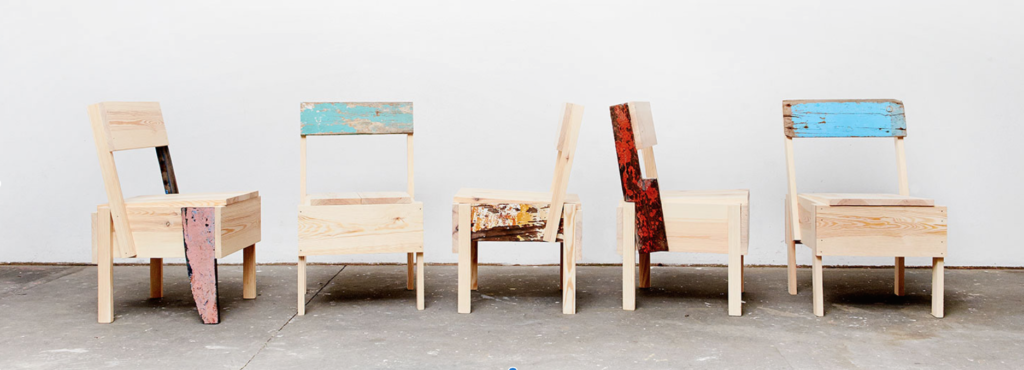
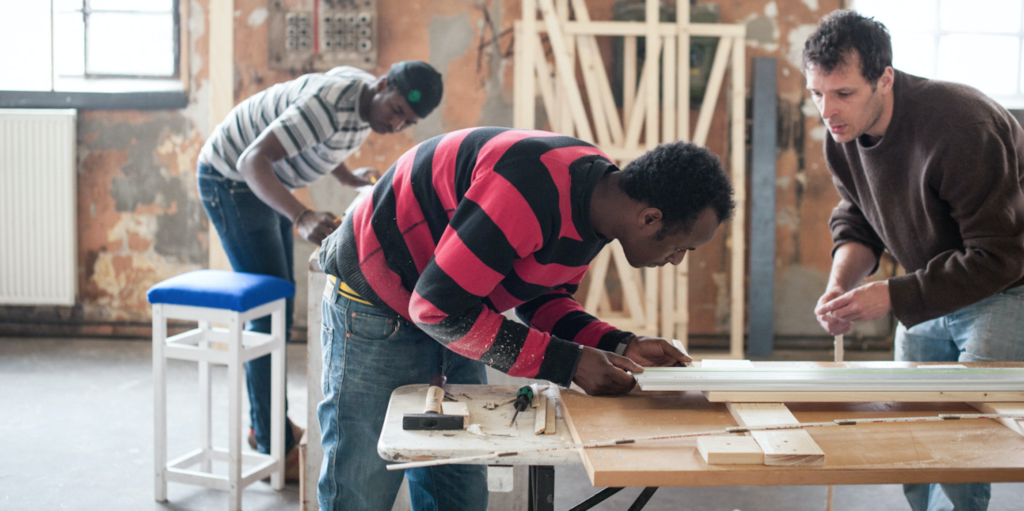


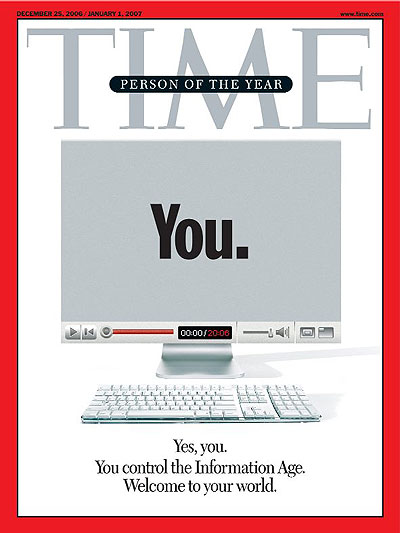

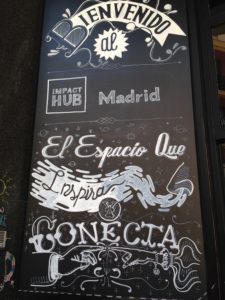

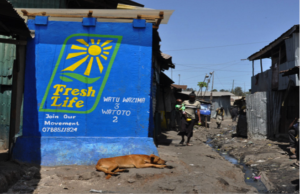

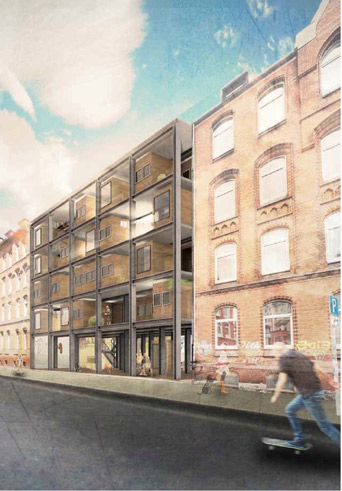
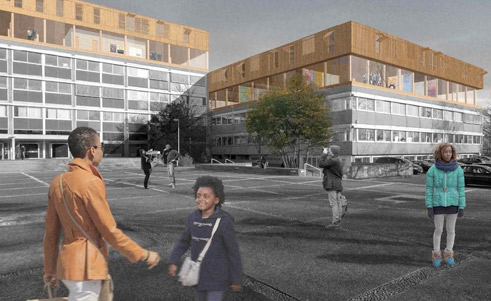
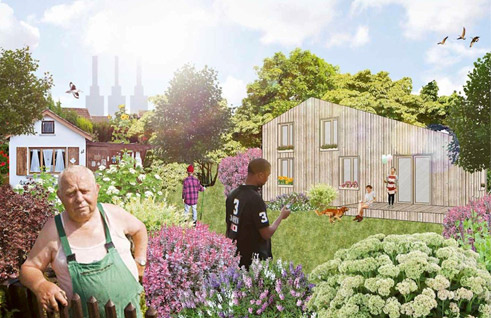
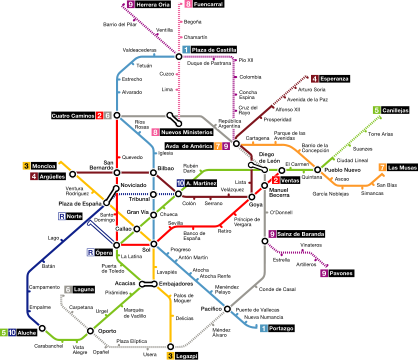
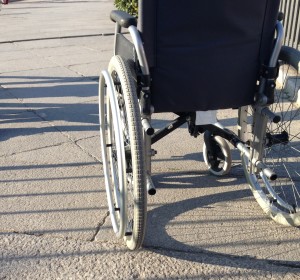
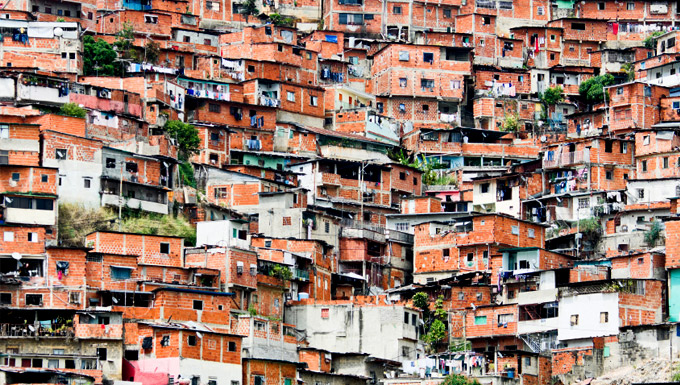

.png)
].gif)
.png)
].png)
].png)
].png)
.png)
].png)
.png)
